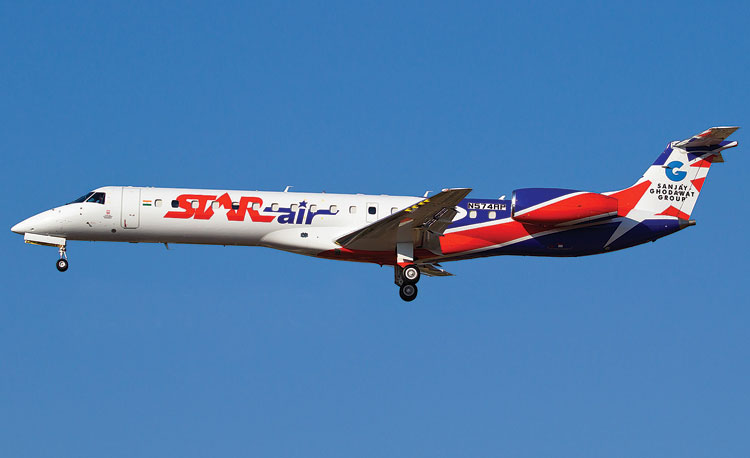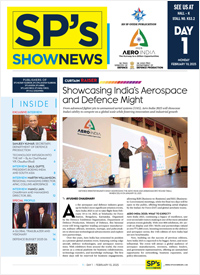- Prime Minister Narendra Modi inaugurates Aero India 2023 in Bengaluru; Releases Commemorative Stamp
- Defence Secretary meets delegations from Saudi Arabia, USA and Oman on the sidelines of Aero India 2023
- Foreign Ministers of 32 countries to attend Aero India 2023
- Embraer showcases the C-390 Millennium at Aero India 2023
Humble scheme lifts India to the cusp of a Civil Aviation Revolution
1,000 incentivised short-haul flights to 100 no-frills airports at the heart of India's take off for the world's 3rd largest aviation market spot

Athousand new domestic routes and 100 new airports in the next five years: That's the near-term goal powering India's flight to the Number 3 spot in the world's aviation market at Round 4 of the UDAN Regional Connectivity Scheme (RCS), which is set to become the global benchmark for making affordable flying accessible to teeming millions.
With 688 new routes already having been awarded – of which 232 have been operationalised so far – across 106 airports and 31 heliports since the launch of the scheme in 2017, UDAN (Udega Desh Ka Aam Nagrik) appears to be reached a take-off stage.
Round 4 for opening up a new tranche of routes was launched on December 3, 2019. The focus is on increasing air connectivity to the North-Eastern states, the hill states, the Union Territories of Jammu and Kashmir and Ladakh and the Island Territories of Andaman & Nicobar and Lakshadweep. Bids for these routes have been invited.
The highlight of Round 4 is the increase in the Viability Gap Funding (VGF) or subsidy cap for Category 2/3 aircraft of more than 20 seats operating on RCS routes in these priority areas.
Under the programme, airlines have to cap fares for 50 per cent of the seats to 2,500 per flight hour. The loss due to the price cap is compensated by the VGF, which is a grant to the airlines to bridge the gap between the cost of operations and revenue.
A key feature of UDAN is that it is not funded through the Government budget. Funds for this programme, including the VGF subsidy, are generated within the sector through a cess imposed on large aircraft operating on trunk routes with high profitability.
The VGF cap applicable for various stage lengths for operation through Category 1 / 1 A aircraft (under-20 seaters) has also been revised to further incentivize the operation of small aircraft under the Scheme.
VGF for Category 2/3 aircraft (more than 20 seats) would be restricted to routes with stage length of up to 600 km in order to promote short-haul routes.
Under a well defined Prioritisation framework, airports already developed by the Airports Authority of India (AAI) would be given higher priority for award of VGF under the Scheme, followed by non-AII airports but located in priority area.
Another key feature introduced at the Round 4 Stage is the allowance of flexibility to the airline to change frequency of flight operations. The Selected Airline Operator (SAO) would be allowed to change the frequency of flight operation on a given route, provided it conforms to the numbers submitted in the Technical Proposal of its bid within a period of one year.
Operation of helicopters and sea planes under NSOP license is also allowed in Round 4.
"AAI would focus on developing no-frills airport in the future and routes connecting such airports would be prioritized for award of VGF. The market would be incentivized to develop short haul routes only, providing connectivity to nearby airports," the Ministry of Civil Aviation (MoCA) stated, while declaring is intention to "operationalise 1,000 routes and more than 100 airports in the next five years" in priority areas which are so far either un-served or underserved in air connectivity.
THE HIGHLIGHT OF ROUND 4 IS THE INCREASE IN THE VIABILITY GAP FUNDING (VGF) OR SUBSIDY CAP FOR CATEGORY 2/3 AIRCRAFT OF MORE THAN 20 SEATS OPERATING ON RCS ROUTES IN THESE PRIORITY AREAS.
"In the last three years MoCA has successfully completed three rounds of bidding under the Scheme and awarded about 700 routes. Efforts are made to develop the airports and operationalise the pending routes. Many of these routes will be operationalised during the winter schedule 2019," the MoCA added.
Regions like the North-Eastern states are major beneficiaries of this programme, with 40 RCS routes having been awarded so far.
"In less than three years of implementation, UDAN has opened up 44 regional airports and transformed the way common people travel," notes Usha Padhee, Joint Secretary Civil Aviation, in a recent write-up. The objective is to promote balanced regional growth and make flying affordable for masses, she states.
RCS is special because it does not depend upon Budgetary support from the Government, and is, instead using funds raised creatively from within the sector and leveraging existing national assets which are lying either unused or under-utilised.
"As land is of very high value, the existing airstrips are like gold mines waiting to be explored. These airstrips, which may belong to state governments, PSUs, defence, private entities, all have been brought under the ambit of the scheme. Upgradation of these airstrips depends on the commitments from the airlines through the bidding process, so that the investment will not become infructuous," states Padhee on the approach to the programme.
UDAN also provides a freight connectivity template to accommodate the Krishi Udaan proposal announced recently in the Union Budget for the airlift of select agricultural produce.
"This convergence between regional air connectivity scheme and agriculture marketing has been envisaged to improve value realisation of niche products especially in North-East and tribal districts.
"A vertical of freighter connectivity under UDAN will become meaningful when there is an integrated supply chain management ensured by the concerned agencies in an eco-system where the role of each agency is defined," Joint Secretary Padhee observes.
India's air passenger traffic stands at 345 million today. With penetration levels currently as low as 7 to 8 per cent, Civil Aviation Minister Hardeep Puri envisages UDAN driving up growth rates in to as high as 25 per cent in the not too distant future. The humble scheme to make flying accessible to the common man has lifted India to the cusp of a civil aviation revolution.





